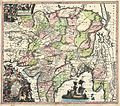Fitxer:1740 Seutter Map of India, Pakistan, Tibet and Afghanistan - Geographicus - IndiaMogolis-seutter-1740.jpg

Mida d'aquesta previsualització: 679 × 600 píxels. Altres resolucions: 272 × 240 píxels | 543 × 480 píxels | 869 × 768 píxels | 1.159 × 1.024 píxels | 2.318 × 2.048 píxels | 5.000 × 4.418 píxels.
Fitxer original (5.000 × 4.418 píxels, mida del fitxer: 8,42 Mo, tipus MIME: image/jpeg)
Historial del fitxer
Cliqueu una data/hora per veure el fitxer tal com era aleshores.
| Data/hora | Miniatura | Dimensions | Usuari/a | Comentari | |
|---|---|---|---|---|---|
| actual | 22:49, 22 març 2011 |  | 5.000 × 4.418 (8,42 Mo) | BotMultichillT | {{subst:User:Multichill/Geographicus |link=http://www.geographicus.com/P/AntiqueMap/IndiaMogolis-seutter-1740 |product_name=1740 Seutter Map of India, Pakistan, Tibet and Afghanistan |map_title=Imperii Magni Mogolis sive Indici Padschach, juxta recentiiss |
Ús del fitxer
La pàgina següent utilitza aquest fitxer:
Ús global del fitxer
Utilització d'aquest fitxer en altres wikis:
- Utilització a ar.wikipedia.org
- Utilització a beta.wikiversity.org
- Utilització a bn.wikipedia.org
- Utilització a cs.wikipedia.org
- Utilització a el.wikipedia.org
- Utilització a en.wikipedia.org
- Utilització a eo.wikipedia.org
- Utilització a es.wikipedia.org
- Utilització a incubator.wikimedia.org
- Utilització a it.wikipedia.org
- Utilització a pnb.wikipedia.org
- Utilització a ru.wikipedia.org
- Utilització a te.wikipedia.org
- Utilització a ur.wikipedia.org
- Utilització a www.wikidata.org



